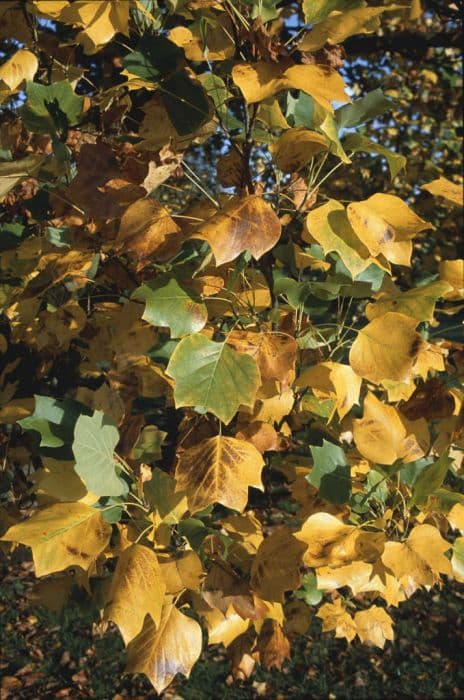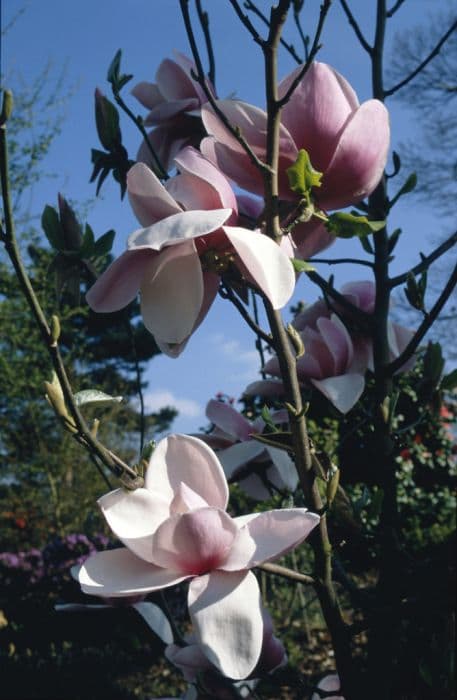Magnolia Magnolia 'Anticipation'

ABOUT
The Magnolia 'Anticipation' is a captivating ornamental plant known for its large, showy flowers that are a sight to behold in the spring. The blossoms are typically a rich, creamy pink color, drawing the eye with their distinctive, cup-like shape. Each flower is opulent and lush, with broad, waxy petals that unfurl to reveal a striking form. These blossoms emit a sweet, pervasive fragrance that can fill the air around the plant. The foliage of the Magnolia 'Anticipation' is also quite handsome, with glossy green leaves that provide a perfect backdrop for the stunning flowers. The leaves have an attractive, leathery texture and are elongated with a smooth edge. As they mature, the leaves deepen into a luscious, dark green shade, making the plant an excellent addition to landscapes for its foliage alone. Overall, the appearance of the Magnolia 'Anticipation' exudes a sense of elegance and drama, thanks to its spectacular flowers and attractive, evergreen leaves. This makes it a popular choice for gardens and parks, where it's often planted for its ornamental value and the beauty it brings to its surroundings throughout the seasons.
About this plant
 Names
NamesFamily
Magnoliaceae
Synonyms
Anticipation Magnolia
Common names
Magnolia 'Anticipation'.
 Toxicity
ToxicityTo humans
Magnolia 'Anticipation', more commonly known simply as Magnolia, is typically considered non-toxic to humans. However, as with any plant material, individual allergic reactions or sensitivities could occur if the plant is ingested. It is always advisable to avoid consuming parts of ornamental plants due to potential individual sensitivities.
To pets
Magnolia 'Anticipation', or Magnolia, is generally considered non-toxic to pets such as dogs and cats. While the Magnolia is not known to contain any toxic principles that would cause serious harm or illness to pets, ingestion of plant material may lead to gastrointestinal upset or discomfort. It is always best to prevent pets from eating plants as even non-toxic plants can cause vomiting, diarrhea, or other mild symptoms due to the mechanical irritation of the gastrointestinal tract.
 Characteristics
CharacteristicsLife cycle
Perennials
Foliage type
Deciduous
Color of leaves
Green
Flower color
Pink
Height
12-15 feet [3.7-4.6 meters]
Spread
10-12 feet [3-3.7 meters]
Plant type
Tree
Hardiness zones
5-9
Native area
Southeast Asia
Benefits
 General Benefits
General Benefits- Aesthetic Appeal: Magnolia 'Anticipation' features large, showy flowers that enhance the visual beauty of gardens and landscapes.
- Seasonal Interest: Its early spring blooms provide color and interest after winter dormancy.
- Fragrance: The flowers emit a pleasant scent, adding a sensory dimension to the garden environment.
- Pollinator Attraction: The blossoms attract bees and other pollinators, contributing to the health of the local ecosystem.
- Shade Provider: As a sizable tree, it offers shade in garden areas during hot summer months.
- Durability: Magnolia 'Anticipation' is relatively hardy and can withstand various climatic conditions once established.
 Medical Properties
Medical Properties- This plant is not used for medical purposes.
 Air-purifying Qualities
Air-purifying QualitiesThis plant is not specifically known for air purifying qualities.
 Other Uses
Other Uses- Culinary Garnish - The petals of the Magnolia can be crystallized and used as an elegant garnish for desserts and special dishes.
- Photography Prop - The striking blooms of the Magnolia make it an excellent subject or backdrop for botanical photography.
- Handmade Paper - Magnolia leaves can be incorporated into handmade paper to add texture and visual interest.
- Aromatherapy - Dried Magnolia petals can be used in homemade potpourri blends or sachets to impart a subtle, floral fragrance.
- Dye Source - The bark and flowers of the Magnolia tree can be used to create natural dyes for textiles and crafts.
- Artistic Inspiration - The form and flowers of the Magnolia tree have long inspired artists and can be used as a muse for paintings and sculptures.
- Floral Crafts - Magnolia petals and leaves can be used in floral crafts, such as wreath making or as components in dried flower arrangements.
- Wedding Decor - With their large, showy flowers, Magnolias are often used in wedding bouquets and as natural decor for ceremonies and receptions.
- Eco-friendly Confetti - Dried Magnolia petals can serve as an eco-friendly confetti alternative for events and celebrations.
- Scented Candles - The essential oil extracted from Magnolia flowers can be used to scent homemade candles, providing a light, sweet aroma.
Interesting Facts
 Feng Shui
Feng ShuiThe Magnolia tree is often associated with purity and nobility in Feng Shui, owing to its beautiful and fragrant blossoms. To utilize this plant in Feng Shui, you need to place it in an area that requires an enhancement of positive chi, such as the entrance of a home to invite good fortune, or in the Southeast corner of a garden to aid wealth and prosperity. The large, lush flowers can also be used to promote romance when placed in the relationship sector of the home, which is typically the Southwest corner.
 Zodiac Sign Compitability
Zodiac Sign CompitabilityThe Magnolia tree is not used in astrology practice.
 Plant Symbolism
Plant Symbolism- Dignity: The magnolia stands tall and displays its flowers with pride, symbolizing self-respect and dignity.
- Nobility: Often found in royal gardens, the magnolia is associated with nobility and is indicative of a person's honorable and refined character.
- Persistence: Magnolias are known to be hardy and can endure harsh conditions, representing the quality of persistence in the face of challenges.
- Feminine Beauty: The delicate and beautiful blossoms of the magnolia are often linked with feminine beauty and grace.
- Purity: The magnolia's white flowers are commonly associated with purity and innocence.
 Water
WaterThe Magnolia 'Anticipation', commonly known as Tulip Magnolia, requires consistent moisture, especially during the first few years after planting to establish a healthy root system. Water the plant deeply once a week, providing about 1 to 1.5 gallons of water each time, depending on the soil condition and climate. During hot and dry spells, increase the watering frequency to twice a week, ensuring the soil stays moist but not waterlogged. Reduce watering in the winter when the plant is dormant. It is important that the water is applied directly to the root zone to encourage deep root growth.
 Light
LightTulip Magnolia thrives best in full sun to partial shade. The ideal spot for this magnolia is an area that receives at least four to six hours of direct sunlight daily, with some dappled shade during the hottest part of the afternoon. Avoid deep shade locations as they can lead to fewer blooms and a less vigorous plant.
 Temperature
TemperatureTulip Magnolia is hardy in a range of temperatures and can tolerate winter lows down to about 10 degrees Fahrenheit. However, the ideal growing temperatures for this plant are between 60 and 70 degrees Fahrenheit. It is resilient in USDA hardiness zones 4 through 9, enduring seasonal weather variations within these zones.
 Pruning
PruningPruning of the Tulip Magnolia should be done to remove dead or damaged wood and to shape the tree, if necessary. It's best to prune immediately after flowering in late spring since the plant sets its flower buds in the previous year. You should not have to prune the tree often—only when you observe dead or broken branches.
 Cleaning
CleaningAs needed
 Soil
SoilThe best soil mix for Magnolia 'Anticipation' is well-draining, rich in organic matter, and slightly acidic with a pH range of about 5.0 to 6.5. A blend of loamy soil, compost, and pine bark can provide a suitable growing medium for this flowering tree.
 Repotting
RepottingMagnolia 'Anticipation' generally does not require frequent repotting as it's often grown as a large shrub or tree. It can be repotted every 3 to 5 years or when it outgrows its current container.
 Humidity & Misting
Humidity & MistingMagnolia 'Anticipation' prefers moderate to high humidity levels. Maintaining ambient humidity around the plant will help mimic its natural environment, though it can tolerate some variation in humidity levels.
 Suitable locations
Suitable locationsIndoor
Place in a bright room, away from direct heat sources.
Outdoor
Plant in partial shade, protect from strong winds.
Hardiness zone
7-9 USDA
 Life cycle
Life cycleThe life cycle of the Magnolia 'Anticipation' begins with seed germination, which requires stratification to imitate winter conditions and prompt the seed to sprout. Following germination, the seedling stage enables the young magnolia to establish a rudimentary root system and foliage to harness sunlight. After several years, the magnolia enters the juvenile stage, where it continues to grow but has not yet reached sexual maturity for flowering. The mature stage is marked by the magnolia's ability to produce the large, fragrant, tulip-shaped flowers that typically appear in early spring before the leaves, signaling full reproductive capability. This plant then repeatedly enters the flowering and seed production cycle annually, attracting pollinators that aid in fertilization and spreading seeds for propagation. The Magnolia 'Anticipation' can live for many decades, as it matures, it gradually slows its growth and enters a phase of senescence before eventually dying.
 Propogation
PropogationPropogation time
Spring-Early Summer
Magnolia 'Anticipation', a beautiful flowering tree known for its large pink blossoms, is often propagated by softwood cuttings. This method is most successful when performed in late spring to early summer, coinciding with the plant's active growth period. To propagate by cuttings, a gardener should select a healthy, non-flowering shoot and cut a 4- to 6-inch (10-15 cm) length, removing the leaves from the lower half of the cutting. The base of the cutting is then dipped in rooting hormone to encourage root development and planted in a moist, well-draining potting mix. The cutting should be kept in a warm area with indirect light; a plastic bag can be placed over the cutting to maintain high humidity. Properly cared for, the cutting will develop roots within a few weeks, after which it can be gradually acclimatized to normal conditions and eventually planted out into the garden.









